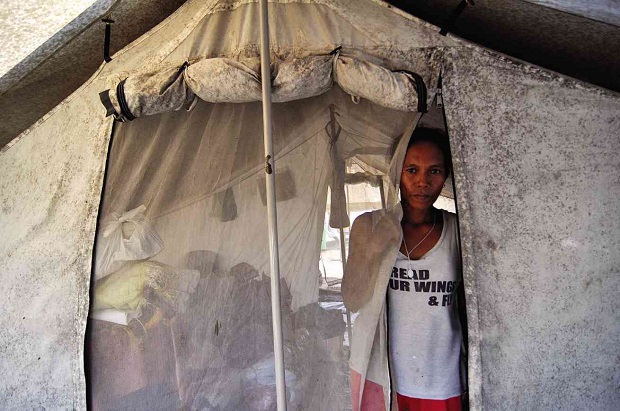
A RESIDENT of one of the many tent cities that have been established for victims of Supertyphoon “Yolanda” steps out of her tent in Guiuan town, Eastern Samar province. RICHARD REYES
CLARK FREEPORT—A psychologist on Tuesday said families traumatized by the storm surges spawned by last year’s Supertyphoon “Yolanda” were not getting enough help to keep themselves sane because of the lack of psychologists who attend to their mental health.
Ma. Lourdes Carandang said local governments must find a way to tap as many psychologists for the full emotional healing of survivors, including those who have migrated to other provinces.
Psychologists from the private and public sectors have volunteered to serve the Visayas region but they are not enough, she said.
“We lack psychologists who work in disaster-stricken areas. In my estimate, if there are 400 psychologists in the Philippines, only 100 are helping out in Leyte and Samar,” she said.
Yolanda, according to government data, affected 591 towns and 57 cities in Eastern Visayas alone. More than 6,000 people were killed by either drowning or being hit by debris.
Carandang led a team here that facilitated four counseling sessions for 15 families that left Leyte province and took refuge in the homes of their relatives in Mabalacat City, Pampanga province.
The intervention was in coordination with the Mabalacat City government, Clark International Airport Corp., Clark Development Corp. and Chile-based funding institute Tiaxa.
Carandang observed that the recovery process for these families could have been more difficult because they were adjusting to a new environment without their usual support system.
She said she and her group, the Institute for Children and Families, had counseled families that survived the 1990 Luzon earthquake that devastated Northern Luzon.
They also train counselors to be able to help more victims. “We had no name for [psychosocial interventions] back then. But then and now, [this part of counseling] usually comes last and draws the least attention. Food, shelter, rescue and repair of infrastructure come first, but emotional healing must follow to help people recover immediately,” Carandang said.
According to her, psychosocial recovery depended on the intensity of the disaster and how fast leaders could build a caring community.
“The purpose of counseling should be to make them powerful, to renew their hope, to reframe their perspective,” she said.
Some of Carandang’s patients here said they planned to build better lives here in Clark.
Domingo and Laura Suyom, one of the couples in the sessions, said they had no plans for now to return to Barangay Bisleg in Tanauan town in Leyte.
They have tried to start a new life in Macapagal Village at the northern periphery of the Clark Freeport Zone, which is accessible to their seven children who settled in Mabalacat years before the disaster struck.
Another couple, who preferred to be identified as Lloyd and Jasmin, said they left Leyte in the aftermath of Yolanda together with their three children, aged 8, 7 and 5.
The safety of their children and their return to a normal life were their priorities, said Jasmin, who drew a cloud and sun during the session to express desire to rise from the disaster.
Concepcion Dacalos, 58, lost her 19-year-old daughter Charmaine when waves swamped Barangay 70 in Tacloban City. “If you live amid the ruins and sadness, sorrow eats you up. So I decided to leave and continue life in Pampanga,” said Dacalos.